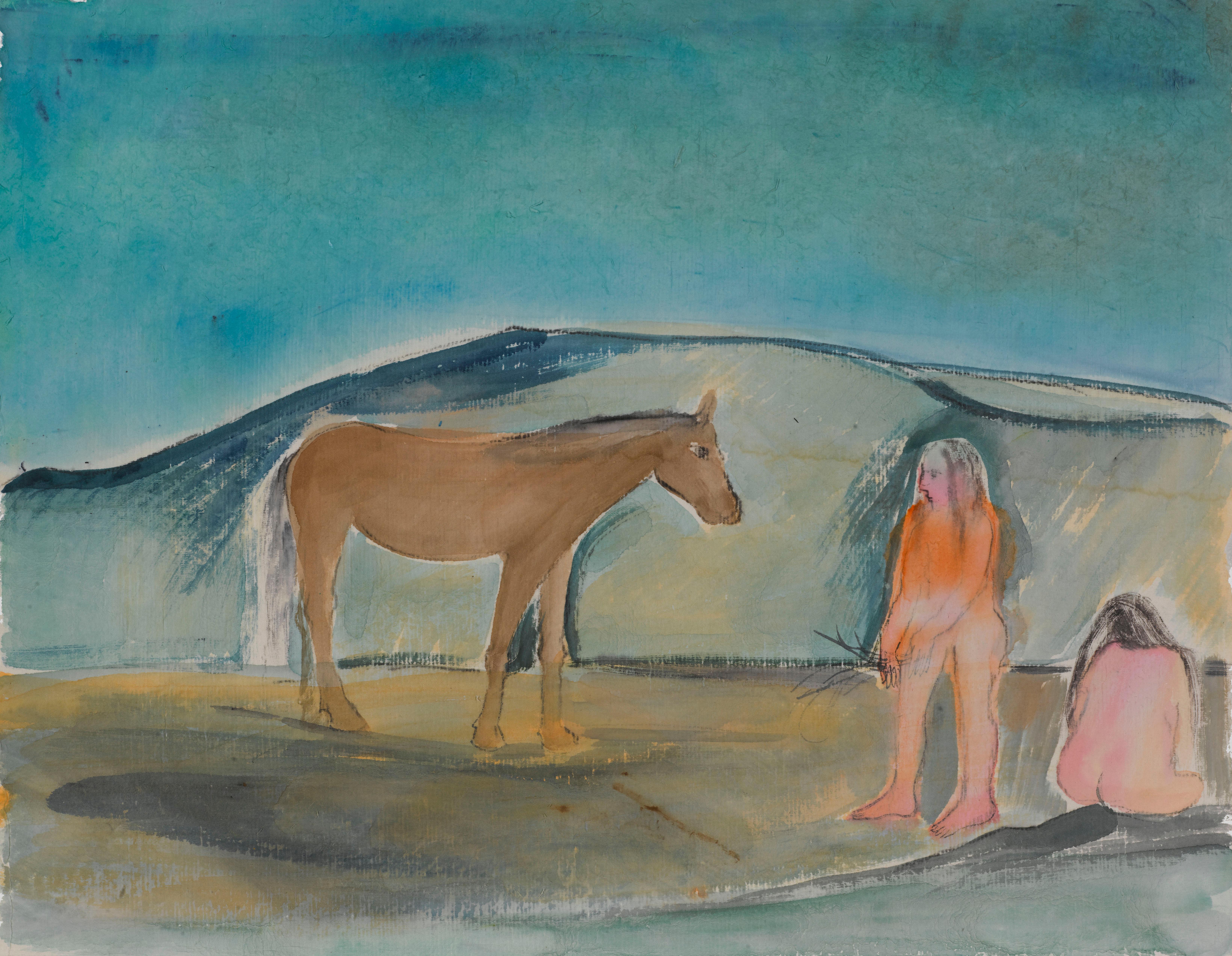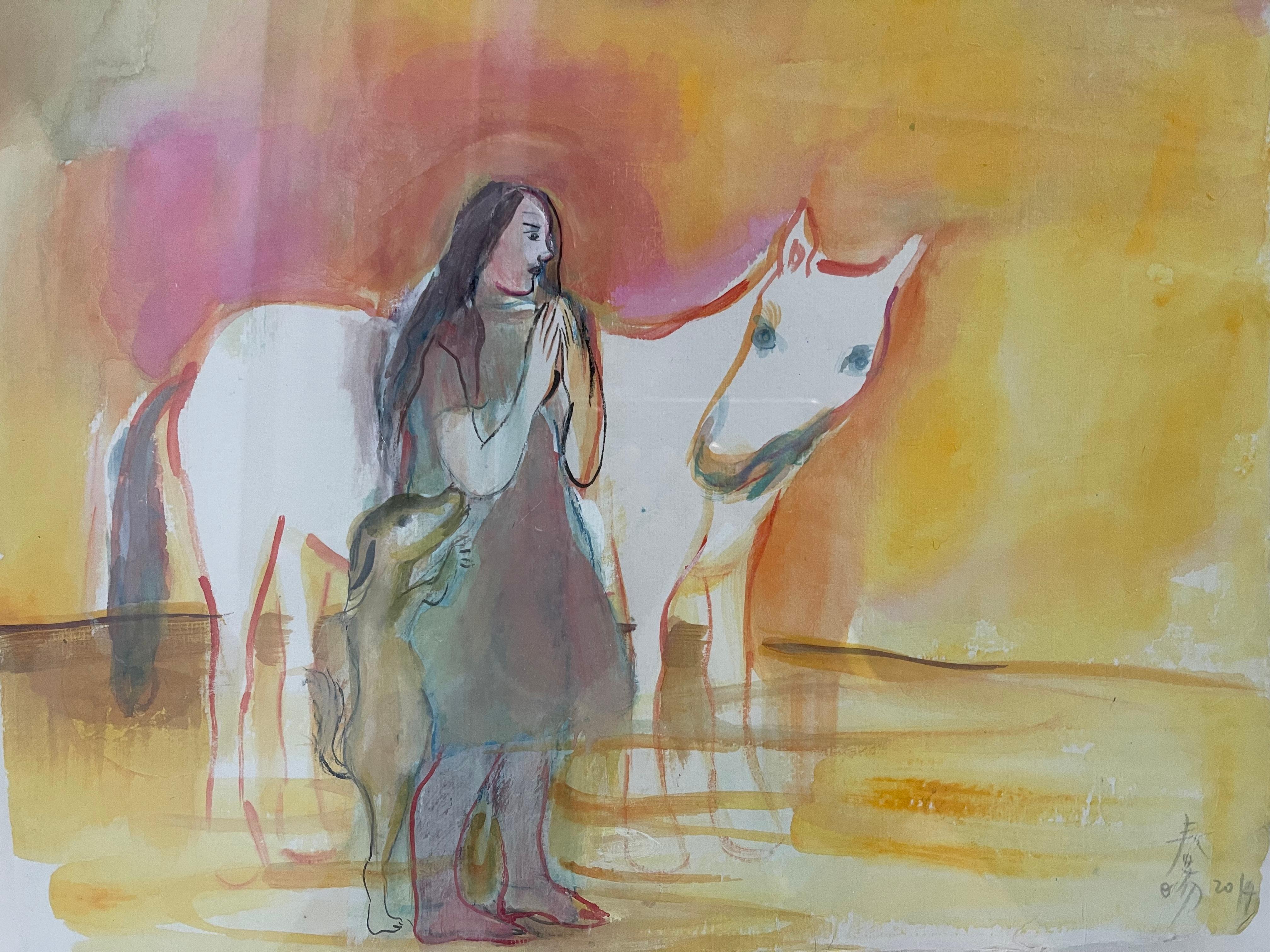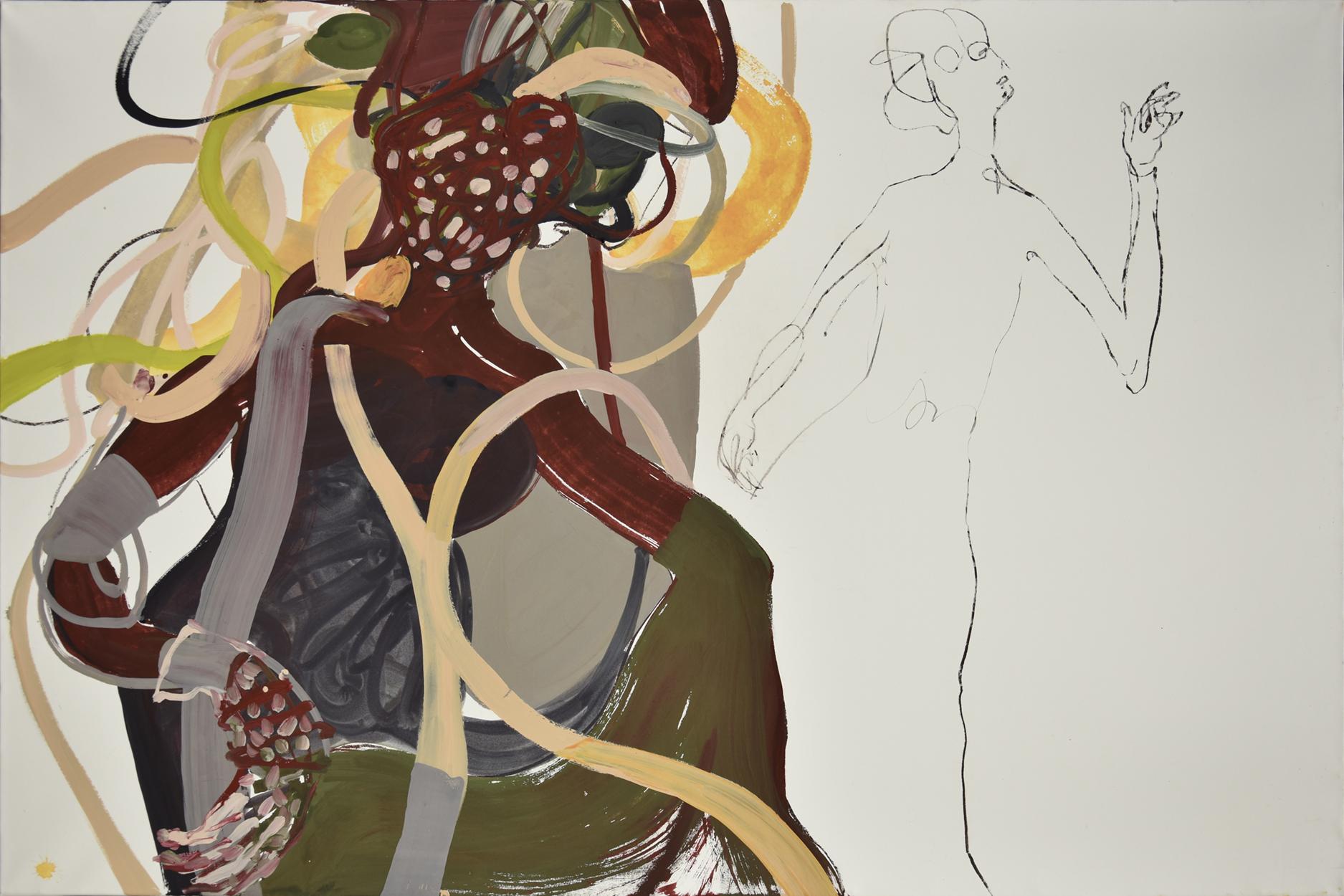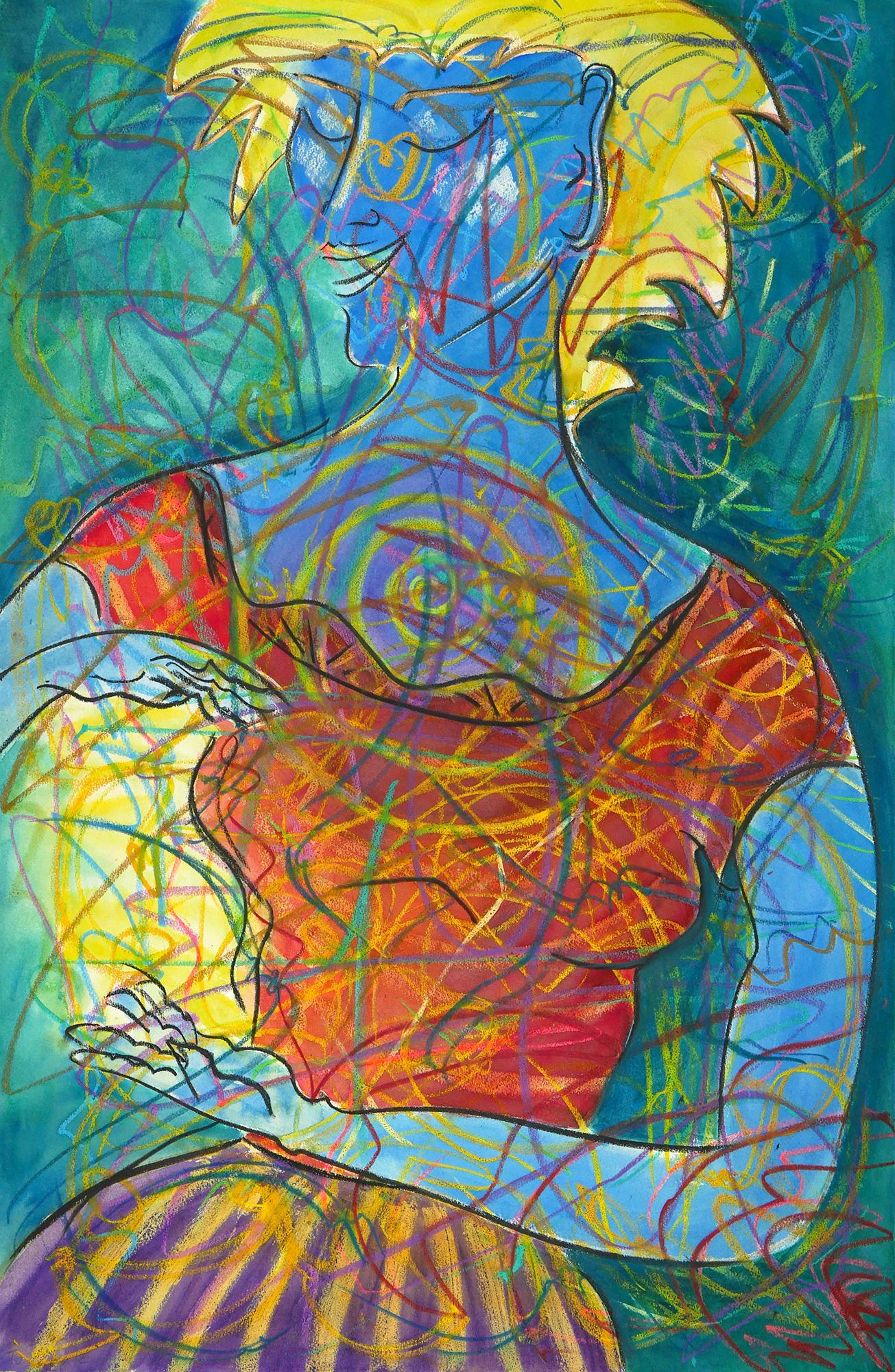Items Similar to Robert Andrew Parker Watercolor "Seated Figure #2" Partially Nude Female
Want more images or videos?
Request additional images or videos from the seller
1 of 7
Robert Andrew ParkerRobert Andrew Parker Watercolor "Seated Figure #2" Partially Nude Female1979
1979
About the Item
"Seated Figure #2" is distinctly vibrant and sexual with a feminine-mystique glow in this stunning example of Robert Parker's Expressionist watercolor. The blue, pink and black creates a brilliant exploding power that engages the viewer immediately leading to the gorgeously rendered partially nude female. On Verso is the label from The Arwin Galleries, Inc., Detroit, Michigan, 1979. It is framed under Museum quality glass, signed and dated on lower left side. Framed it measures 23.5 x 24 inches.
Robert Parker was born in Norfolk, Virginia. At 21 he attended the school of the Art Institute of Chicago from 1948 until 1952. He studied with Jack Levine & Henry V. Poor at the Skowhegan School of Painting and Sculpture in Maine and at William Hayter's Atelier 17 in New York. Since his first solo show in 1954, Parker has exhibited extensively, and his credits include set designs for opera and film as well as book illustrations. His illustrations have graced more than 90 children's books, plus numerous literary classics by heavyweight authors from Franz Kafka to Joseph Heller. A fine art painter with a populist, improvisational flair, he's also done commissioned illustrations for a rack full of major publications ranging from The New Yorker and Esquire to Sports Illustrated and Playboy.
In his watercolors Parker combines areas of pure color with design conceived in terms of silhouette and shape. He takes his subject matter mostly from the natural world—dogs, trees, mountains, people, birds—and condenses and simplifies imagery with a swift, expressionistic technique. During his career Parker has worked in such distinctive locales as Arles and Saint-Remy in France and the Himalayas, where a 1981 walking tour provided the subjects for a series on landscapes and fellow trekkers.
“Robert Andrew Parker is one of the most accurate and at the same time most unliteral of painters,” the poet Marianne Moore wrote of him. “He combines the mystical and the actual, working both in an abstract and a realistic way.”
Art and jazz have been two long-running passions in the life of Robert Andrew Parker, artist, illustrator, writer and globe-trotting witty water colorist of national renown and a professional jazz drummer of solid repute in the Northwest Corner of the state of Connecticut.
Parker's artworks are in the collections of such prestigious venues as the Metropolitan Museum of Art, the Whitney Museum, the Brooklyn Museum, the Los Angeles County Museum of Art, the Art Institute of Chicago and, at the New Britain Museum of American Art, New Britain, Connecticut.
His awards include a Ranger Fund Purchase Prize, Guggenheim Fellowship, Rosenthal Foundation Grant and a Tamarind Lithography Workshop Fellowship.
- Creator:Robert Andrew Parker (1927, American)
- Creation Year:1979
- Dimensions:Height: 27.5 in (69.85 cm)Width: 28 in (71.12 cm)
- Medium:
- Movement & Style:
- Period:
- Condition:
- Gallery Location:Detroit, MI
- Reference Number:1stDibs: LU128615550741
About the Seller
5.0
Gold Seller
These expertly vetted sellers are highly rated and consistently exceed customer expectations.
Established in 2014
1stDibs seller since 2019
95 sales on 1stDibs
Typical response time: 2 hours
- ShippingRetrieving quote...Ships From: Detroit, MI
- Return PolicyA return for this item may be initiated within 14 days of delivery.
More From This SellerView All
- "Mental Capacity" Mixed Media, Fictional Image of African American, Iconic ColorBy Onzie NormanLocated in Detroit, MI"Mental Capacity" is a fictional experience whereby an African American man from the 1970s discovers his artistic side. It is generally known that most people are either left brain o...Category
2010s Expressionist Mixed Media
MaterialsResin, Paper, Acrylic
- Michael Patrix Oil Painting "Head of Woman"Located in Detroit, MI"Head of Woman" is a wonderfully exciting example of Mid-20th century Expressionist art. This vibrant portrait is reminiscent of Matisse's Fauvist female...Category
Mid-20th Century Expressionist Figurative Paintings
MaterialsCanvas, Oil
- "Untitled Female"By Richard WilsonLocated in Detroit, MI“Untitled Female" is a colorful piece by Richard Wilson that has meaning for native Detroiters through use of the blues and oranges - their "Tiger" baseball team's colors and the "D"...Category
2010s Expressionist Figurative Paintings
MaterialsCanvas, Acrylic
- Richard Wilson Figurative Female Iconic Detroit SymbolsBy Richard WilsonLocated in Detroit, MI“Untitled Female" is a colorful piece by Richard Wilson that has meaning for native Detroiters through use of the blues and oranges - their "Tiger" baseball team's colors and the "D"...Category
2010s Expressionist Figurative Paintings
MaterialsCanvas, Acrylic
- "Untitled Female" Clothed Female Figure, Bright Colors, Detroit SymbolsBy Richard WilsonLocated in Detroit, MI“Untitled Female" is a colorful piece by Richard Wilson that has meaning for native Detroiters through use of the blues and oranges - their "Tiger" baseball team's colors and the "D"...Category
2010s Expressionist Figurative Paintings
MaterialsCanvas, Acrylic
- Fanny Rabel Figurative Oil Painting Soulful, PrayerfulBy Fanny RabelLocated in Detroit, MISALE ONE WEEK ONLY UNTITLED by Fanny Rabel a Mexican artist who was born in Poland in 1922 is a soul wrenching work depicting among other things, the children killed by Nazi bombing in Spain during the Second World War. The lavender and purple surrounding the seated female figure and the kneeling child suggest both grief for the innocents' deaths and the prayers being offered for an end to the carnage. The bright gold and red can be read as either explosions or the hopeful light of redemption after death. Like Picasso's Guernica from 1937, this painting from 1965 can stand as a powerful anti-war statement. Numerous key galleries and museums such as Morton Auctions, Cerro de Mayka have featured Fanny Rabel's work in the past. Her anti-Nazi and anti-Fascism politics resulted in her participation in a mural called Retrato de la Burguesía in 1940 for the Sindicato Mexicano de Electricistas building on Alfonso Caso Street in Mexico City. Rabel met a group of exiled Spaniards in Mexico along with Antonio Pujol, who invited her to take part in a mural project headed by him, David Alfaro Siqueiros, Joseph Renau, Luis Arenal, Antonio Rodríguez Luna and Miguel Prieto. The artist died in 2008. Fanny Rabel born August 27, 1922, in Poland born Fanny Rabinovich, was a Polish-born Mexican artist who is considered to be the first modern female muralist and one of the youngest associated with the Mexican muralism of the early to the mid-20th century. She and her family arrived in Mexico in 1938 from Europe and she studied art at the Escuela Nacional de Pintura, Escultura y Grabado "La Esmeralda", where she met and became friends with Frida Kahlo. She became the only female member of “Los Fridos” a group of students under Kahlo’s tutelage. She also worked as an assistant and apprentice to Diego Rivera and David Alfaro Siqueiros, painting several murals of her own during her career. The most significant of these is "Ronda en el tiempo" at the Museo Nacional de Antropología in Mexico City. She also created canvases and other works, with children often featured in her work, and was one of the first of her generation to work with ecological themes in a series of works begun in 1979. She is considered to be the first female muralist in Mexico. She was an assistant to Diego Rivera while he worked on the frescos for the National Palace and an apprentice to David Alfaro Siqueiros. Her most important mural is Ronda en el tiempo located in the Museo Nacional de Antropología, which was created from 1964 to 1965. She also created murals at the Unidad de Lavaderos Público de Tepalcatitlán (1945), Sobrevivencia, Alfabetización in Coyoacán in 1952 Sobrevivencia de un pueblo at the Centro Deportivo Israelita (1957) Hacia la salud for the Hospital Infantil de México (1982), La familia mexicana at the Registro Público de la Propiedad (1984) (which Rabel preferred to title Abolición de la propiedad privada) and at the Imprenta Artgraf. In collaboration with other artists, she participated in the creation of the murals at the La Rosita pulque bar (disappeared) and at the Casa de la Madre Soltera. She entered the Escuela Nacional de Pintura, Escultura y Grabado "La Esmeralda" shortly after it was established in 1942, taking classes with José Chávez Morado, Feliciano Peña and Frida Kahlo, with whom she became close friends. She changed her last name from Rabinovich to Rabel during her career. Rabel married urologist Jaime Woolrich and had two children Abel and Paloma Woolrich, both of whom became actors. The first exhibition of her work was in 1945 with twenty-four oils, thirteen drawings, and eight engravings at the Liga Popular Israelita with Frida Kahlo writing the presentation. In 1955, she had an individual exhibition at the Salón de la Plástica Mexicana. She had a large exhibition at the Museum of the Palacio de Bellas Artes to commemorate a half-century of her work. Her last exhibition was in 2007 at the Universidad Autónoma Metropolitana. Her work can be found in collections in over fifteen countries including those of the New York Public Library, the Library of Congress in Washington, D.C., the Royal Academy of Denmark, the National Library in Paris, the Casa de las Américas in Havana, the Benemérita Universidad Autónoma de Puebla and the Museo de Arte Moderno in Mexico City. A retrospective of her work after her death called Retrospectiva in Memoriam, Fanny Rabel (1922-2008) was held at the Museum of the Universidad Popular Autónoma del Estado de Puebla . She is considered to be the first modern female muralist in Mexico although she also did significant work in painting, engraving, drawing, and ceramic sculpture. Her work has been classified as poetic Surrealism, Neo-expressionism and is also considered part of the Escuela Mexicana de Pintura (the dominant art movement of the early to mid 20th century in Mexico) as one of the youngest muralists to be associated with it along with Arnold Belkin and José Hernández Delga. Rabel was more drawn to depicting mankind’s pain rather than happiness, sharing other Mexican muralists' concerns about social injustice. However, she stated to Leopoldo Méndez that she could not create combative works, with clenched fists and fierce faces, and she wanted to leave the Taller de Gráfica Popular. Méndez convinced her to stay, saying that more tender images are important to political struggle as well. Children with Mexican faces...Category
1960s Expressionist Figurative Paintings
MaterialsOil, Canvas
You May Also Like
- Expressionist Figurative water color painting- Series The Horse Whisper No.2-24Located in Beijing, CNExpressionist Figurative water color painting by Zhang Chunyang Series The Horse Whisper No.2-24 Dimension: 29 x 36 cm Material: Gouache, Watercolor on Paper Date: 2013 Artist Bi...Category
2010s Expressionist Figurative Drawings and Watercolors
MaterialsWatercolor, Gouache, Handmade Paper
- Expressionist Figurative water color painting- Series The Horse Whisper No.2-25Located in Beijing, CNExpressionist Figurative water color painting by Zhang Chunyang Series The Horse Whisper No.2-25 Dimension: 29 x 36 cm Material: Gouache, Watercolor on Paper Date: 2013 Artist B...Category
2010s Expressionist Figurative Drawings and Watercolors
MaterialsWatercolor, Gouache, Handmade Paper
- Expressionist Figurative water color painting- LuckinessLocated in Beijing, CNExpressionist Figurative water color painting by Zhang Chunyang Title: Luckiness Dimension: 29 x 36 cm Material: Gouache, Watercolor on Paper D...Category
2010s Expressionist Figurative Drawings and Watercolors
MaterialsWatercolor, Gouache, Handmade Paper
- French Contemporary Art by Sandra Detourbet - SaphoBy Sandra DetourbetLocated in Paris, IDFGouache on canvas & handmade paper Sandra Detourbet is a French artist born in 1967 who works & lives in Ivry-sur-Seine, near Paris. She is graduated in 1997 from ENSAD in Paris, Ar...Category
2010s Expressionist Abstract Paintings
MaterialsCanvas, Gouache, Handmade Paper
- Lights of the Temple, colorful on black, dynamic, goddess, abstract, energyBy Janet MorganLocated in Brooklyn, NYWatercolor, mixed mediaCategory
2010s Expressionist Paintings
MaterialsMixed Media, Watercolor, Archival Paper
- Holder of Light, Wild Woman Series, bright color blue yellowBy Janet MorganLocated in Brooklyn, NYThis painting is in a series called the Wild Woman which is also printed in a pocket sized book. Watercolor, mixed media, using resists. Janet Morgan’s...Category
2010s Expressionist Figurative Drawings and Watercolors
MaterialsMixed Media, Watercolor, Archival Paper





